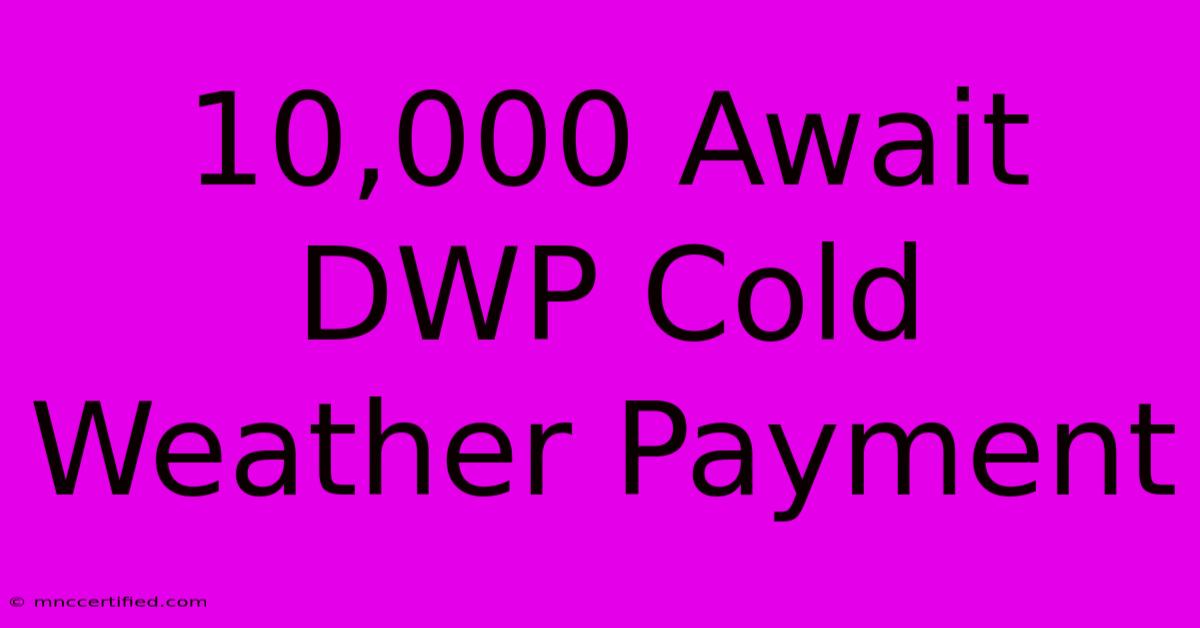10,000 Await DWP Cold Weather Payment

Table of Contents
10,000 Await DWP Cold Weather Payments: What You Need to Know
The Department for Work and Pensions (DWP) is preparing to issue cold weather payments to thousands of vulnerable individuals across the UK. With an estimated 10,000 people expected to receive these vital payments, understanding the eligibility criteria and the process is crucial. This article will guide you through everything you need to know about the DWP cold weather payment scheme, ensuring you're well-informed about this vital financial support.
Understanding DWP Cold Weather Payments
Cold weather payments are a crucial part of the UK government's support system, designed to help vulnerable individuals and families cope with the financial strain of exceptionally cold weather. These payments are triggered automatically when the average temperature in your area drops to or below 0°C for seven consecutive days. This isn't a blanket payment for everyone; eligibility is carefully determined based on specific criteria.
Who is Eligible for a Cold Weather Payment?
To receive a DWP cold weather payment, you must be receiving one of the following benefits:
- Pension Credit
- Income Support
- Income-based Jobseeker's Allowance
- Income-related Employment and Support Allowance
- Universal Credit
It's important to note that not everyone receiving these benefits will automatically qualify. The payment is triggered by the temperature in your specific postcode area, so even if you receive one of the listed benefits, you won't receive a payment unless the temperature threshold is met.
How Much is a Cold Weather Payment?
Each cold weather payment amounts to £25. This payment is designed to provide a small but significant boost to help cover extra heating costs during periods of freezing weather. Multiple payments can be issued if the average temperature remains below 0°C for consecutive seven-day periods throughout the winter months.
Checking Your Eligibility and Payment Status
The DWP cold weather payment system is largely automated. You don't need to apply separately; if you're eligible and the temperature triggers a payment in your area, the money will be automatically added to your existing benefit payment.
However, it's always a good idea to check your payment status. You can do this by:
- Checking your bank or building society account: The payment should appear as a separate transaction.
- Contacting the DWP directly: If you haven't received a payment and believe you are eligible, contact the DWP to inquire.
Remember to keep your contact details up to date with the DWP to ensure you receive any important information regarding your benefits.
What to Do if You Don't Receive a Payment
If you believe you are eligible for a DWP cold weather payment but haven't received one, don't hesitate to contact the DWP. They can investigate your case and ensure you receive the financial support you're entitled to. Having accurate and updated information about your circumstances is essential for a smooth process.
Beyond the Payment: Further Support for Cold Weather
The DWP cold weather payment is one part of a broader strategy to support vulnerable individuals during harsh winters. Remember to explore other options available to you, such as:
- Warm Home Discount Scheme: This scheme provides a one-off discount on your electricity bill.
- Local council support: Your local council may offer additional support, such as grants or advice on energy efficiency.
- Energy efficiency improvements: Consider making improvements to your home's insulation to reduce energy consumption.
The DWP cold weather payment is a lifeline for many, offering crucial financial assistance during difficult winter months. By understanding the eligibility criteria, payment process, and available support, you can ensure you're prepared and ready to navigate the colder months. Remember to check your eligibility and stay informed about further support available to you.

Thank you for visiting our website wich cover about 10,000 Await DWP Cold Weather Payment. We hope the information provided has been useful to you. Feel free to contact us if you have any questions or need further assistance. See you next time and dont miss to bookmark.
Featured Posts
-
Turkey Sandwich Savory Blueberry Jam Recipe
Nov 29, 2024
-
Cost U Less Insurance Redding
Nov 29, 2024
-
Andrea Jenkyns Joins Farages Party
Nov 29, 2024
-
5 Viral Spirit Tunnel Scenes Jennifer
Nov 29, 2024
-
Cuic Insurance Online Payment
Nov 29, 2024